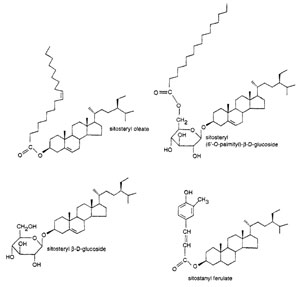For the developed world
The only plant-derived food product on the market where nutritional health benefits are claimed (as opposed to implied) is the enrichment of margarines with plant sterol and stanol esters for the reduction in plasma cholesterol levels (Fig. 7.1). These products do not require the development of specifically bred plants since it is possible to extract stanols and sterols from existing plants (albeit in the case of the stanols from the bark of a tree) for use in their manufacture.
Experiments with plant stanolesters were shown to lower serumcholesterol consistently by about10–15%and LDL-cholesterol by about 20% in patients with high serum cholesterol levels as well as in normal individuals [16, 17]. Similar effects have been seen with plant sterolesters but at least 1g/day of plant sterols need to be consumed [18]. Consequently they require extraction and addition to foods.
As campesterol esters are better absorbed than sitosterol esters, serum levels of campesterol could rise to those levels that are found in the very few people who suffer toxic symptoms from phytosterolemia. Thus there may a benefit in increasing the sitosterolto campesterol ratio in plants.
The ideal situation would befor sufficient sterols to be present in our diets to ensure that plasmacholestero levels are kept reasonably low without the need to buy a specific functional food, and that they would be in a fat soluble form for effective uptake. The evidence favours in increasing order of preference the use of:
- plant sterolesters with low campe sterol contents
- sterol esters from tall oil (derived from pine wood) which havea higher stanol content than edible oils
- plant stanolesters.





